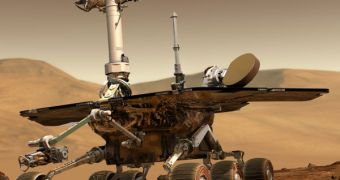The twin geologic rovers that were deployed more than 5 years ago on Mars, NASA's Spirit and Opportunity, managed to survive their fifth season on the Red Planet, despite the fact that they were expected to last less than 3 months in the frigid winter that their unfamiliar surroundings offered. Now, having survived more than 20 times their life expectancy, they are heading to new horizons, exploring rocks and craters, in an attempt to determine if water existed on Mars, and how it helped shape the landscape of the planet.
"The American taxpayer was told three months for each rover was the prime mission plan. The twins have worked almost 20 times that long. That's an extraordinary return of investment in these challenging budgetary times," said in a statement NASA's science missions associate administrator Ed Weiler, working from the Agency's Washington DC headquarters.
Though operating the machines in these circumstances requires about $20 million annually, NASA representatives say that this is barely a fraction of the price the taxpayers would have to endure in order to send more robots on Mars. It's estimated that Spirit and Opportunity do the job of 4 space missions each year, which means that they have already supplied sufficient data to render 20 exploration missions to Mars unnecessary.
"We keep setting the bar higher for what these rovers can do. Once it seemed like a crazy idea to go to Endeavour, but now we're doing it," added mission manager Frank Hartman, one of those who drive the rovers. The expert, working at NASA's Jet Propulsion Laboratory (JPL) in Pasadena, California, explained that Endeavour – a large crater, more than 14 miles (22 kilometers) across – is Opportunity's next target, located some 7 miles (12 km) from the rover's current position.
"These rovers are incredibly resilient considering the extreme environment the hardware experiences every day. We realize that a major rover component on either vehicle could fail at any time and end a mission with no advance notice, but on the other hand, we could accomplish the equivalent duration of four more prime missions on each rover in the year ahead," concluded JPL expert John Callas, NASA's rover project manager.

 14 DAY TRIAL //
14 DAY TRIAL //